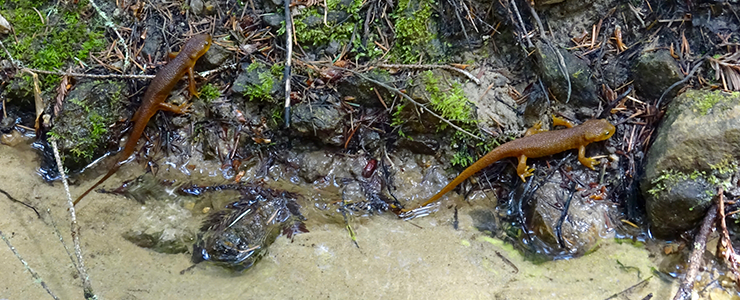Seven Springs
Seven Springs (90 acres)
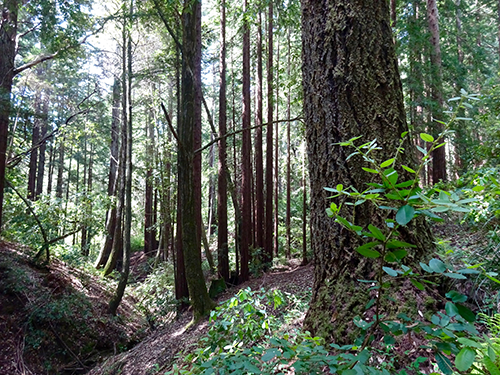 General Description: The Seven Springs area includes springs that form the headwaters of Cave Gulch, as well as the northern stretches of the gulch’s stream itself and sections of mixed evergreen forest, redwood forest, and northern maritime chaparral. ENVS Professor Greg Gilbert’s 16-ha Forest Ecology Research Plot (FERP) is also located within the Seven Springs parcel. The western edge of the parcel abuts the Cave Gulch neighborhood of Bonny Doon, from which equestrian enthusiasts and mountain bikers access the reserve without authorization.
General Description: The Seven Springs area includes springs that form the headwaters of Cave Gulch, as well as the northern stretches of the gulch’s stream itself and sections of mixed evergreen forest, redwood forest, and northern maritime chaparral. ENVS Professor Greg Gilbert’s 16-ha Forest Ecology Research Plot (FERP) is also located within the Seven Springs parcel. The western edge of the parcel abuts the Cave Gulch neighborhood of Bonny Doon, from which equestrian enthusiasts and mountain bikers access the reserve without authorization.
Geology: According to Stanley (1982), three rock units occur in the chaparral and mixed evergreen forest area. Ben Lomond quartz diorite underlies the two small stream courses in this region. A sedimentary cover of Santa Margarita sandstone occurs from just west of Empire Grade to east of the Seven Springs trail. Another narrow strip of Ben Lomond quartz diorite adjoins a large area of schist; some areas of Santa Margarita sandstone also occur there.
Soil types found in the stream courses of the northwest portion of campus are Sheridan rocky sandy loam and Holland sandy loam. An unnamed sandy loam, in places with claypan, is developed on the Santa Margarita sandstone. Felton loam and Hugo rocky loam overly the schist, with sandy loams overlying the areas of Santa Margarita sandstone.
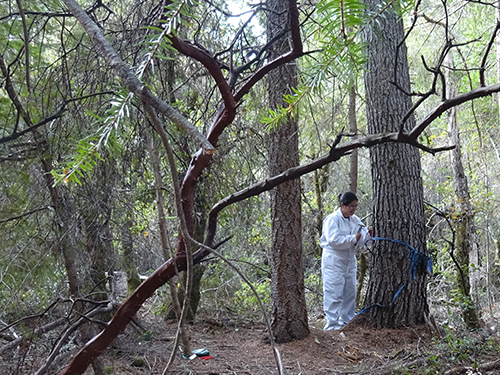 Plants: The sandy chaparral northwest of the (fire road junction) water tanks is the only stand of this chaparral type left on campus. It grows here in an unusually flat area for this vegetation type (Weiner and Norris 1983. According to Stone (1983), three species of manzanita dominate the shrub element of the sandy chaparral: brittle-leaf manzanita (Arctostaphylos crustacea), heartleaf manzanita (A. andersonii), and sensitive manzanita (A. sensitiva), the southern range limit of which occurs on campus. Chamise (Adenostoma fasciculatum) and warty-leaved ceanothus (Ceanothus papillosus) are also common in the sandy chaparral. Of significance are two hybrid species that are especially abundant in the transition zone between chaparral and mixed evergreen forest: a coast/Shreve’s oak hybrid, and a hybrid between warty-leaved and blue-bush ceanothus (C. thrysiflorus).
Plants: The sandy chaparral northwest of the (fire road junction) water tanks is the only stand of this chaparral type left on campus. It grows here in an unusually flat area for this vegetation type (Weiner and Norris 1983. According to Stone (1983), three species of manzanita dominate the shrub element of the sandy chaparral: brittle-leaf manzanita (Arctostaphylos crustacea), heartleaf manzanita (A. andersonii), and sensitive manzanita (A. sensitiva), the southern range limit of which occurs on campus. Chamise (Adenostoma fasciculatum) and warty-leaved ceanothus (Ceanothus papillosus) are also common in the sandy chaparral. Of significance are two hybrid species that are especially abundant in the transition zone between chaparral and mixed evergreen forest: a coast/Shreve’s oak hybrid, and a hybrid between warty-leaved and blue-bush ceanothus (C. thrysiflorus).
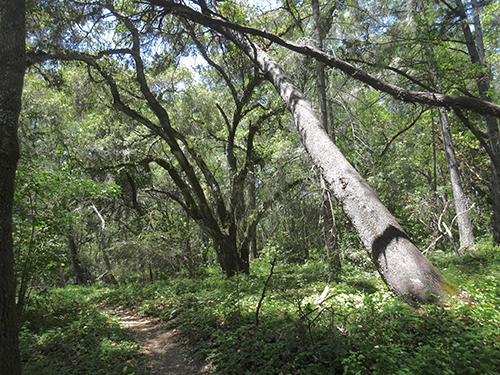
The ponderosa pines found in this section of the reserve, as well as in Crown Meadow in the Seep Zone section of the reserve, should also be of interest to botanists. In the Santa Cruz Mountains, ponderosa pines are restricted to inland marine sands deposited approximately 10 million years ago (Stone 1983). According to Stone, “The ponderosa pine population in the Santa Cruz Mountains is quite disjunct from
the continuous range of this species, and the Santa Cruz pines are distinct in some respects from the ponderosas found in some of the neighboring central coast ranges.” Stone (1983) notes that support is growing for the idea that the Santa Cruz ponderosa pine may be worthy of varietal or subspecies status, and in fact the varietal name Pinus ponderosa var. benthamiana has been proposed by Hartweg.
The large area of the reserve near the West Loop is dominated by mixed evergreen forest. An extensive stand of mixed evergreen forest, which includes the portion of the UCSC Forest Ecology Research Plot (FERP) established in 2007, with small areas of grassland interspersed lies to the northwest of the chaparral community.
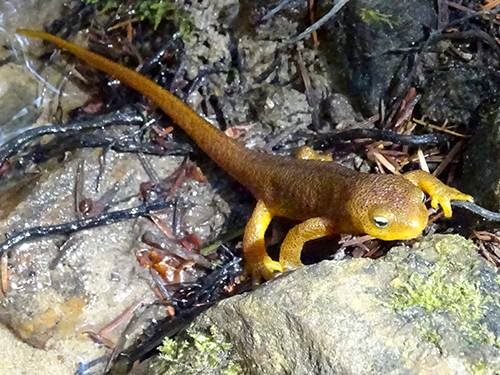 Animals: The mosaic of chaparral and the surrounding mixed evergreen forest supports more vertebrate species than any other campus vegetation community. The adjacent stands of chaparral and small grasslands make this area of the reserve a rich site for animal studies.
Animals: The mosaic of chaparral and the surrounding mixed evergreen forest supports more vertebrate species than any other campus vegetation community. The adjacent stands of chaparral and small grasslands make this area of the reserve a rich site for animal studies.
Management: The chaparral communities of campus have been the site of a number of class and individual student projects and invasive species management activities. The chaparral patch bounded by West Road, Red Hill Road, and the two Fuel Break Roads—only a small portion of which lies within the CNR— has been subject to prescribed fire in the early 1980s (Brown and Norris 1985). These fire-dependent communities could again receive active management, which could create a patchwork of seral stages. This presence of chaparral in various stages of growth, from newly burned (for fire management) to senescent, could be an especially valuable study resource.
Opportunities for teaching, research, and stewardship: The 16-ha Forest Ecology Research Plot (FERP) lies within the Seven Springs area of the CNR. Woody stems within the long term research plot are re-censused every 5 years by undergraduate interns. The 400 m x 400 m plot is composed of 20 m x 20 m quadrats marked by PVC corner posts. Other studies, such as the Small Mammal Undergraduate Research in Forests (SMURF) project, use this grid of quadrats and have FERP vegetation data available for use. The Seven Springs area is too far of a walk for most course activities, as it takes 1/2 hour or more to walk there from the core of campus. This restricts its use for classes, though longer field trips (3 hours, for example) can allow for exploration of the area. The chaparral patch within the Seven Springs can be used for comparative study with other chaparral patches on campus as well as surrounding forest lands. Stewardship opportunities include trail maintenance, restoration, and potential closures on and around the Seven Springs trail, restoration of a large headcut gully on the Seven Springs trail, use of prescribed fire in the chaparral, and invasive species management.
